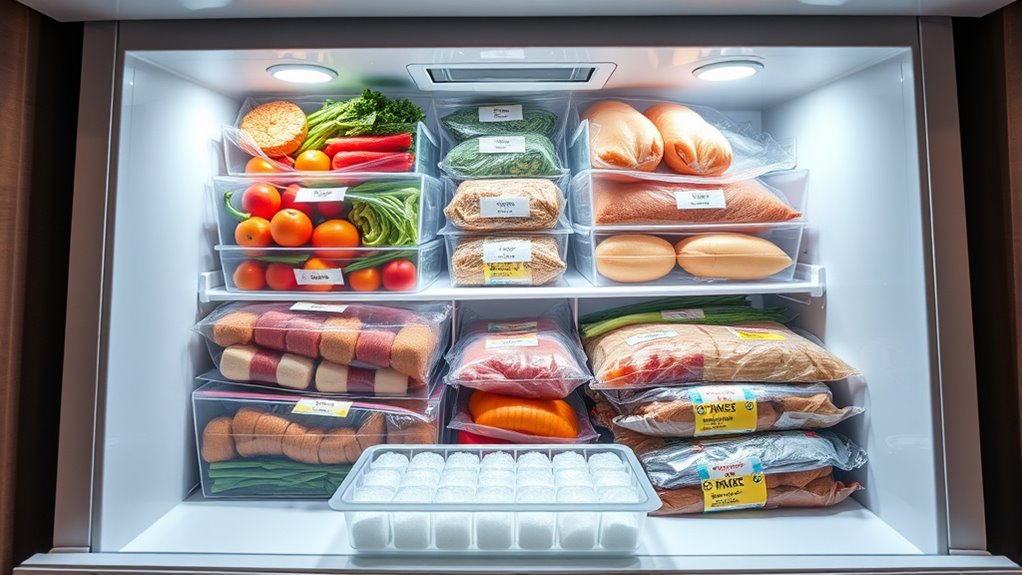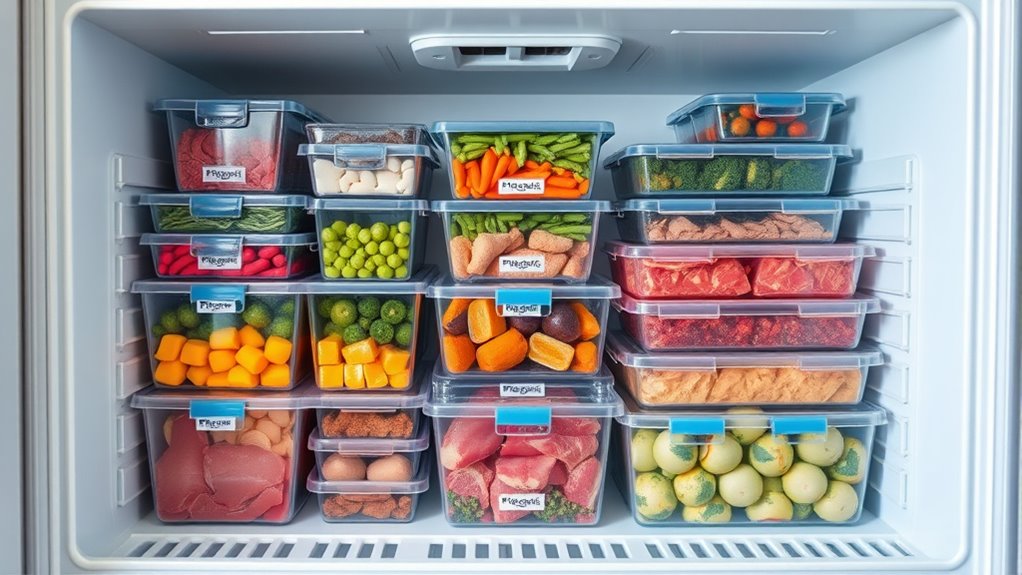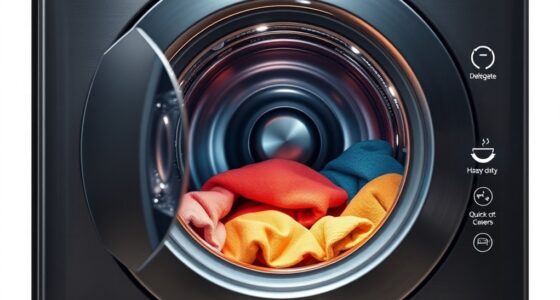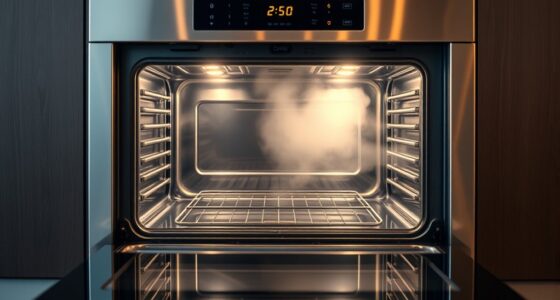To prevent food waste in your chest freezer, start by emptying and cleaning it thoroughly. Group similar items like meats or vegetables, then store them in clear, labeled, airtight containers or bins, placing newer items behind older ones for easy rotation. Keep frequently used foods accessible at the front and utilize vertical storage solutions to maximize space. Regularly review and reorganize your freezer to maintain good airflow and prevent spoilage, and discover more tips to keep your freezer efficient and organized.
Key Takeaways
- Empty and clean the freezer regularly to prevent ice buildup and identify expired or spoiled items.
- Group similar foods and use clear, labeled containers to streamline access and monitor freshness.
- Implement a “first in, first out” system, placing newer items behind older ones for proper rotation.
- Store frequently used items at the front or top for easy access, and less-used items in the back or bottom.
- Maintain organized storage with vertical solutions and schedule periodic reorganizations to ensure proper airflow and prevent waste.

Ever wondered how to keep your chest freezer neat and easy to navigate? The key lies in smart organization that not only simplifies your life but also helps prevent food waste. When your freezer is cluttered, it’s easy to lose track of what’s inside, leading to forgotten items that eventually spoil. To avoid this, start by emptying your freezer completely. As you do, check each item’s date and discard anything that’s expired or unlikely to be used. Clearing out old food creates space and gives you a fresh start for better organization.
Next, consider grouping similar foods together. For example, keep all meats in one area, vegetables in another, and baked goods in a separate section. Use clear, stackable containers or labeled bins to keep these groups contained. This way, you can quickly locate what you need without rummaging through piles of frozen items. When stacking containers, ensure they’re airtight to prevent freezer burn and preserve freshness. Label each container with the contents and the date it was frozen. This simple step helps you prioritize what to use first and reduces the chance of forgotten food turning to waste.
Implement a rotation system like “first in, first out.” Place newer items behind older ones so you naturally use the older products first. This minimizes the risk of food sitting too long and spoiling. Regularly review your freezer’s contents—every few months—and plan meals around items nearing their expiration date. If you find items you’re no longer interested in eating, don’t hesitate to donate or discard them. Staying proactive with your inventory prevents clutter and keeps your freezer running efficiently. Incorporating proper freezer organization techniques also helps maintain optimal temperature and food quality.
Another effective trick is to utilize vertical storage solutions. Use stackable baskets or tiered shelves to maximize space and make everything more accessible. Keep frequently used items near the top or front for easy grabbing, while less-used items can go towards the back or underneath. This arrangement saves time and effort, reducing the temptation to leave food behind or forget about it. Also, avoid overstuffing your freezer, as cold air needs room to circulate properly. Proper airflow keeps the temperature consistent, which helps maintain food quality and prevents spoilage.
Finally, develop a habit of cleaning your freezer regularly. Every few months, defrost if needed, wipe down surfaces, and reorganize. This upkeep prevents ice buildup and keeps your storage system functioning smoothly. When you combine these organization techniques, you create a well-ordered freezer that minimizes waste, saves money, and ensures you always have healthy, delicious food on hand.
Frequently Asked Questions
How Often Should I Defrost My Chest Freezer?
You should defrost your chest freezer when a thick layer of ice, about a quarter-inch or more, has built up. Typically, this means doing it every 6 to 12 months. Keep an eye on frost buildup, and if you notice the freezer running less efficiently or struggling to maintain temperature, it’s time to defrost. Regular defrosting helps your freezer work efficiently and prevents food waste caused by spoilage.
What Are the Best Labels for Freezer Organization?
Labels are your secret weapon for freezer organization. Opt for clear, waterproof labels with bold text—think of them as signposts guiding you through your frozen kingdom. Use a dry-erase marker for easy updates or pre-printed labels for consistency. Categorize items by type or meal, and date everything. This way, you’ll swiftly find what you need and prevent food waste—making your freezer both efficient and clutter-free.
How Can I Prevent Freezer Burn on Stored Food?
To prevent freezer burn, you should tightly wrap your food with plastic wrap or aluminum foil, then place it in airtight, moisture-proof containers or freezer bags. Remove as much air as possible before sealing to minimize ice crystal formation. Label your items with dates so you use older foods first. Keep the freezer at 0°F or below, and avoid opening it frequently to maintain a consistent temperature.
What Is the Ideal Temperature for a Chest Freezer?
Think of your chest freezer as a frozen fortress—keeping food at the perfect temperature is key. The ideal setting is 0°F (-18°C), which halts bacteria and prevents ice crystals from forming. By maintaining this temperature, you ensure your food stays fresh longer, like a treasure waiting to be discovered. Regularly check the thermostat to keep your frozen kingdom secure and your food waste minimize.
How Do I Safely Store Large Quantities of Frozen Food?
You should store large quantities of frozen food in airtight, moisture-proof containers or heavy-duty freezer bags to prevent freezer burn and contamination. Label each package with the date to track freshness. Keep the freezer at 0°F (-18°C) or lower, and organize items by type or expiration date for easy access. Avoid overloading the freezer to guarantee proper airflow, which helps maintain consistent temperature and food safety.
Conclusion
By organizing your chest freezer, you turn chaos into a well-orchestrated symphony, where every item has its place. This simple step helps prevent food waste and saves you money, making your kitchen feel less like a cluttered attic and more like a sanctuary of efficiency. With a little effort, you’ll keep your frozen treasures fresh and ready, transforming your freezer into a reliable guardian of your food’s journey from freezer to fork.









